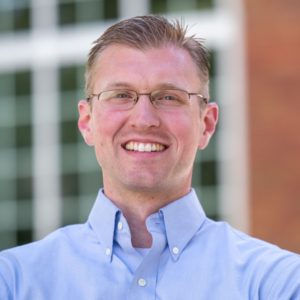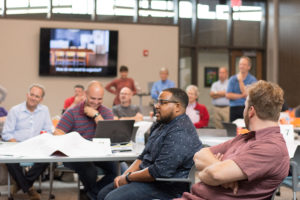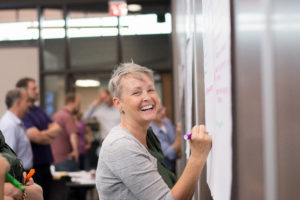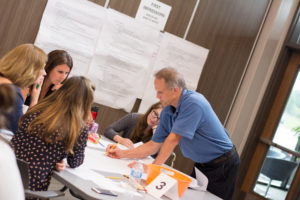Willoughby Ohio is known for being an idyllic “small town” in Northeastern Ohio. However most don’t know that even though it’s small, it made a huge impact in the founding of modern medical and educational facilities in our state. The secret to understanding this, is found in the name of our city…Willoughby.
It’s easy to ignore a town’s name, relegating it to the “dust bin,” of history, but there is a lot in a name. Charlton, Chagrin and Chagrin Mills–all of those were given to our community before the early citizens settled on Willoughby. In 1834, the residents (under 400 people at the time–and a lot of cats from the grist mill) changed the town name to “Willoughby,” after Dr. Westel Willoughby, a medical doctor serving in New York state. The suggestion came from Dr. George W. Card and Dr. John M. Henderson, two of his students, who founded the Willoughby University of Lake Erie, trying to draw their teacher, Dr. Willoughby, to support their medical school. Their big ambition? To create the most advanced medical school in Northeast Ohio.
Unfortunately, the doctor didn’t relocate to Ohio, but was so honored by their efforts, that he donated a complete medical library, he outlined the first year’s curriculum and sent $1,200 in support to the fledgling school. They had his blessing, despite the long distance. Around that time, the city incorporated and adopted his name. This signaled the beginning of advanced medical education in Northeast Ohio.
From the start, education influenced the story of our city.
Educations Impact in Willoughby
While hopes were high for the school, The Willoughby University of Lake Erie only operated between 1834-1846. It produced 618 graduates, 160 of which were doctors. They fanned out across the region, helping those in need and starting practices all over the state. This group was educated in modern methods of medicine (like using anesthesia for surgical operations—aren’t we glad for that?) and included anatomy, chemistry and surgery. Many of their techniques were controversial and when the source of cadavers for the anatomy classes were discovered, there was a huge public outcry. (Grave robbing always gets you in trouble with the public!). This, combined with a loss of funding and internal disagreements shuttered the university in 1847. The faculty dispersed but many of them ultimately seeded medical schools elsewhere in the state. Both the Case Western Reserve School of Medicine and The Ohio State University College of Medicine, trace their roots through these early pioneers.
Specifically, the OSU College of Medicine traces its lineage through the original Willoughby University of Lake Erie. OSU states, “The College [of Medicine] stands upon a foundation of six medical schools with a continuity of college life spanning 178 years.” This makes them the second oldest medical college in the state incorporating all the major medical disciplines.
So even though the Willoughby University of Lake Erie was shuttered in 1847, The Willoughby Female Seminary assumed the building and opened shortly afterwards. This educational institution was one of the first female colleges in Northeast Ohio. It was novel at the time since opportunities for women to enroll in higher education was not a common occurrence. It was dedicated to educating women in math, music, art, language, and philosophy. Due to its popularity, it enrolled 100 women in the first year of operation.
So, the little town of Willoughby, was named after an educator and doctor. While it wasn’t specifically known for medicine or education, it seeded world renowned medical and educational schools, was home to advances in medicine and supported women’s education, long before this was commonly accepted.
All that buried in the name of our city!
Transition to Modern History
During the late nineteenth and early 20th century, Willoughby was a peaceful oasis outside of Cleveland, Ohio. Later this idea would be further popularized by the Twilight Zone episode, “A Stop at Willoughby”. Cleveland, which was a busy metropolis, offered many economic opportunities for American workers and its proximity to nearby communities fronting Lake Erie, furthered its appeal. Even though automobiles were common in Cleveland in the early 1900’s, the advent of expressways in the early 1940s shortened time it took motorists to travel outside the city. When the national Interstate Highway System came through in late 1950s and mid-1970s, it more easily allowed those living in Cleveland to enjoy cottages or second homes in the surrounding cities–Willoughby being one. Cleveland continued developing and more and more people living in this urban environment, could easily travel and enjoy smaller lake front communities.
Today, Willoughby continues to build on its “small town roots” but still providing easy access to Cleveland. A thriving downtown promotes many community activities. One activity is the annual “ArtsFest.” This downtown gathering brings together over 140 juried artists, musicians, and local food, all centered around the downtown neighborhood. Another event is the “Last Stop Willoughby Parade” which celebrates the Willoughby’s historic connection to the rail industry in Cleveland.
City leadership regularly, meets with surrounding municipal leaders to strategize on issues facing their communities. (Even if it’s just to record a Facebook video together, encouraging citizens to enjoy a doughnut or beer when businesses reopen.) In 1980, Richard Gaede F.A.I.A. was hired to conduct a study of Downtown Willoughby, redesign the streetscape, foster economic viability, and preserve the central historic district. On November 29, 1995 approximately nine blocks centered around the junction of Erie and River Streets and Euclid Avenue in Downtown Willoughby were placed on the National Historic Register, recognizing the architectural importance of the structures to the community, and further promoting business downtown.
While there are always ups and downs, education continues to be a regular focus of the Willoughby-Eastlake communities, with a recent $155 million bond issue passing narrowly, providing funding for the construction of three new schools in the area, along with a new YMCA and senior center.
The Fine Arts Association, was established by Jim and Louise Savage. Early on, it was hosted in their home, but has expanded through the generations to its current home on Mentor avenue. The Association is provides music and art lessons for young people, grants scholarships and sponsors other art related activities in the community. The Savages, who were masters at “getting things done” dedicated themselves to creating a space to provide opportunities for education in the fine arts. Now, 62 years later, the FAA enhances the lives of over 60,000 people annually through classes in theater, music, dance, and art, and stands as one of the preeminent organization to advocate for art education in Northeast Ohio.
What is in a name? Historically, Willoughby foreshadowed a major impact in education, medicine, and the arts. Our community continues its tradition of promoting education, and fostering a strong sense of civic pride and that reaches far back to its historic roots.
Let’s work together to make education better. Interested in speaking with us? Get in touch!
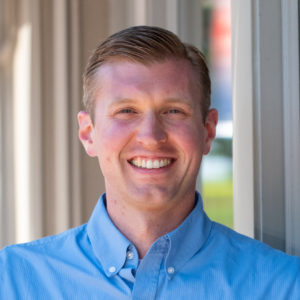
Ryan Caswell
Communications
Get our newsletter with insights, events and tips.
Recent Posts:
Brunswick High School Senior Seminar Presentations
New Mentor High School Baseball Field Opens
North Ridgeville Visual Preference Exercise
Meet the Designers: Katherine Mitchell
Garfield Heights High School Stadium Groundbreaking
